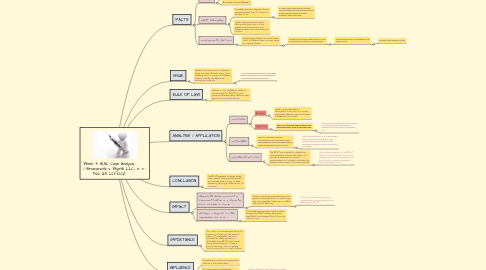
1. FACTS
1.1. PARTIES
1.1.1. Wyeth, LLC (Wyeth Laboratories)
1.1.2. Bruesewitz, Russell (Appellant)
1.2. WHAT HAPPENED
1.2.1. Russell Bruesewitz's daughter, Hannah, was administered the DTP vaccine on October 21, 1991.
1.2.1.1. 24 hours after receiving the vaccine Hannah began having seizures, and was diagnosed with "residual seizure disorder" many years later.
1.2.2. Wyeth Laboratories was sued, in Pennsylvania state court, on the premise that the vaccine was a defective design that caused Hannah's condition.
1.3. PROCEDURAL HISTORY
1.3.1. Initially brought before the United Sates Court of Federal Claims and was denied by a Special Master.
1.3.1.1. Moved to the United States District Court for the Eastern District of Pennsylvania.
1.3.1.1.1. United States Court of Appeals for the Third Circuit.
2. ISSUE
2.1. Whether the vaccine was a defective design that led to Hannah's injury from receiving the DTP vaccine, and whether Lederle could be held liable under Pennsylvania state law.
2.1.1. Can a vaccine manufacturer can be held liable from death or injury resulting from a properly administered vaccine.
3. RULE OF LAW
3.1. Whether or not the National Childhood Vaccine Injury Act (NCVIA) of 1986 prevents state level design-defects claims against vaccine manufacturers.
4. ANALYSIS / APPLICATION
4.1. POSITIONS
4.1.1. Brusewitz
4.1.1.1. Wyeth can be held liable in Pennsylvania state court for injuries received by Hannah when she received a defective DTP vaccine.
4.1.2. Wyeth, LLC
4.1.2.1. The NCVIA prevents the company from being held liable, even at the State level.
4.1.2.1.1. The company believed it sold the vaccine in accordance with the standards required to prevent liability (packaging, etc..)
4.2. REASONING
4.2.1. The NCVIA protects vaccine manufacturers from lawsuits in state court, when the vaccine is administered within the guidelines of the NCVIA.
4.2.1.1. The intent of the NCVIA is to encourage vaccine producers to operate in the United States, and to produce new vaccines and keep the costs of vaccines reasonable.
4.3. EXPANSION OF LAW
4.3.1. The NCVIA was intended to stabilize the vaccine market in the United States, and provide an incentive for vaccine manufacturers to continue to produce the medicine without fear of frivolous lawsuits.
4.3.1.1. Without the protection of the NCVIA, there is no good business case for a company to produce a vaccine in the United States, creating a potential large-scale health crisis.
5. CONCLUSION
5.1. The NCVIA preempts all design-defect claims against vaccine manufacturers who are sued due to injury or death caused by the proper administration of a vaccine.
6. IMPACT
6.1. AMERICAN HOME PRODUCTS CORPORATION et al. v. FERRARI et al., October 6, 2008
6.1.1. Ferrari sued vaccine manufacturers for injuries sustained by their son, which they way was caused by thimerosal, an additive that contains Mercury.
6.1.1.1. The court found that the vaccine manufacturer was protected from liability by the NCVIA.
6.2. HOLMES v. MERCK CO INC, September 25, 2012
6.2.1. A child died approximately 6 months after receiving the MMR vaccine, the parents sued Merck and received $250K from the "Vaccine Court".
7. IMPORTANCE
7.1. This case is of extreme importance to a business professional in the vaccine industry. The Supreme Court has affirmed the liability protections afforded by the NCVIA, which would have profound impacts on future business decisions, such as applying funds towards R&D of a new vaccine.
8. INFLUENCE
8.1. Companies will continue to manufacture vaccines in the United States.
8.2. The government has established processes to instill public confidence in vaccine programs.
8.2.1. Vaccine Adverse Event Reporting System is an example of a venue for consumers to report issues with vaccines.
